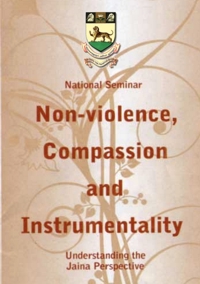 | Non-violence, Compassion and InstrumentalityA Jaina PerspectiveSeminar organized by the Department of Jainology of the University of Madras, 13 and 14 February 2009 Chennai, India |
14.02.2009
2.02 Ahiṁsā and Compassion for Ecology
Abstract
The Jain system could be the basis of scientific ecology of the future. A comparison is made between mainstream scientific principles and Jain principles regarding omnipresence of souls in the universe, eternity of the soul, ahimsa and aparigraha. The concept of compassion is also discussed.
-------
It is quite a defendable standpoint to call the Tīrthaṁkara Mahāvīra the Father of Ecology. His famous saying, some 2600 years ago: ‘Parāsparopagraho jīvanam’ can be interpreted in various ways. It can be translated as ‘all forms of life (or consciousness) are connected in mutual support and dependence’ or ‘all creatures are there to help one another’ or ‘all living beings are interdependent.’
Ecology, and its practical application - the care for our environment and the globe on which we live - has become an important science in the last few decades. According to the scientific definition, here taken from Webster’s Third International Dictionary, ‘Ecology is the science concerned with the interconnectedness of things, especially as manifested by natural cycles and rhythms.’
Occidental ecology, however, studies an ecosystem or ecological unit as a togetherness of individuals each one striving for its own benefit, adapting to the changing biological, physical and chemical environment. At best, beings cooperate because they co-evolved into a condition of mutual benefit. The interdependence of certain creatures, such as figs and fig-wasps, insects and flowers, monkeys and fruits, has been established by accidental evolutionary steps according to the still prevailing Darwinist and neo-Darwinist theories. This has finally led ‘by chance’ to a situation which is beneficial to each. Being successful, even the possibility of independence was selected away. What is hidden beneath the surface of ecological and evolutionary theory is a metaphysical motivation of self-preservation, success for oneself, and selfishness in general - the innate property of physical matter. There is in this pessimistic occidental view no recognition of an inherent factor of service to a greater purpose in nature, nor service to the community of all beings on earth, nor of a harmonious overtone which all beings (unconsciously, semi-consciously, or consciously) obey. The West has lost the idea of a divine presence pervading all things. The West has lost the feeling of a spiritual key-tone which, like the drone of the tempura, reflects the ever-presence of the divine, from which all comes, and to which all souls return. For me, however, life is like a spiritual musical score according to which each plays (or tries to play) its individual tune in the universal symphony. The predominant scientific opinion - which regrettably was also adopted by most Indian scientists, posits only “blind” matter - no intelligence, nor divine consciousness or beauty and harmony as inherent parts of an ecosystem. Yet, who does not stand in awe when allowing him or herself to be engulfed by the soft sounds of a tropical rainforest, the pristine beauty of a newly opened flower or when abiding in places of primordial purity in nature?
Compare the occidental scientific feelings and thoughts with Mahāvīra’s simple saying that all forms of conscious life are connected in mutual support and dependence, or they are there to help each other. It means there is not only interconnectedness as a result of the automatic workings of nature, but also means, that there is a conscious purpose: to support and help, not only on an individual basis, but including all. Just as humankind is composed of individuals, families, groups, nations all of which finally form humanity itself, so also is ecology composed of individuals, family relations, ecosystems and finally, the whole earth - including the human species.
Jainism teaches us some very fundamental values, which I hope will, in time, be adopted by the world at large.
1. Every realm of nature is ensouled by numerous jīvas or souls, each of which has a consciousness, is consciousness, and each of which has one or more senses, and finally a mind and conscious intelligence. So each entity is aware, has the ability to feel joy and suffering, acts in its own way and through karma builds its own future. Thus every jīva experiences and grows, is dependent on all others, and has an influence on all others.
If we make a small and incomplete table of the realms of nature and compare them with the dominating modern scientific classification, we see a clear difference between Jainism and Materialism:
Jainism | Having | Having | Accepted Science | Having | Having |
Basic matter (pudgala) | no | no | Atoms or subatomic particles | no | no |
Subtle matter | no | no | Energies | no | no |
Invisible super- and sub-terrestrial beings | yes
| yes | Forces and energies | no | no |
Element lives (1-sensed): |
|
| Mineral kingdom, consisting of 92 ‘atomic’ chemical elements | no | no |
Nigodas (basic life forms, 1-sensed) | yes | yes | Basic life-forms | yes | ? |
Plants | yes | yes | Plants | yes | ? |
Animals | yes | yes | Animals | yes | (yes) |
Humans | yes | yes | Humans | yes | yes |
Past-human (hell-beings) | yes | yes | (?) | -- | -- |
Past-human (celestial beings), ‘divinities’ | yes | yes | -- | -- | -- |
Liberated beings | yes | yes (om-niscient) | -- | -- | -- |
2. Every jīva (i.e. conscious, living being) exists for eternity, though it dresses itself subsequently in innumerable forms, and goes through millions of stages of development. The soul-inspired tendency is naturally upwards, i.e. evolutionary. Its form and conditions of life are, however, determined by its karma, i.e. the law of cause and effect in consciousness. By conscious choice, even the simplest being influences its own future and whether it will then feel good or bad. And at the same time every soul influences, and is influenced by, every other soul in the universe. Therefore every soul has the potential to cause suffering and relieve the suffering of others. The first is called Cruelty, the second is called Compassion. So naturally, compassion flows forth from Mahāvīra’s famous pronouncement.
Important is, that every single being continues to exist, whereas according to the traditional Western mind of the last few centuries, every consciousness is a new creation, a product of the combination of chemical atoms and molecules. Moreover, every soul ceases to exist at physical death. So why worry about the future, other than our immediate satisfaction and joy? Kill an animal and eat it - so what? It would cease to exist anyway in a few years.
But in Jainism, if damage is done it is done to an eternal soul by an eternal soul. Events can not be washed away by mere physical death. Effects may take place over periods of thousands or millions of years. And - effects always come back to the doer. A criminal will be a victim of crime in the future, even though he dies and is reborn many times.
3. The most central pillar on which the Jain system rests is ahiṁsā, i.e. non-violence, harmlessness. It is the truly spiritual Principle of Jainism. One can be a Hindu, a Christian, a Muslim, and still in some way support and defend the idea of violence. One can not be a Jain and at the same time support and defend violence.
For an ecology based on Jainism, all forms of life need to be respected. Ideally, no jīva should ever experience obstruction and suffering as a result of its dependence on others. Think of the consequences: no wars, no hunting, no meat consumption, no cruel thoughts even in human minds, no capital punishment, no terrorism. There exists no good that can justify evil. Jains can not serve any god by causing harm to any living being, because the very essence of divinity is harmlessness. There would not even be mining, tapping of oil from the earth, or pollution of water, air or earth so that the water-bodied, air-bodied and earth-bodied lives would be harmed, nor those who are dependent on them.
Therefore Jainism can form the basis for the most perfect understanding and practice of ecology: Study nature from the perspective of consciousness and universal wellbeing. Respect all and cause no harm. Don’t kill to study life (this is impossible!). Live in and with nature, be her servant and she will be your servant and your spiritual teacher. It is predicted that such a time will come when a lion will drink from the same cup as a cow, at least allegorically - or that different human characters will understand that, despite their varying viewpoints, they are all brothers in the soul, dependent on each other and on all other living beings. The Jain system of thought is like a most refined, pure and beautiful temple of the mind - with Non-violence as its greatest idol and purity as its walls. However, it will take many centuries before utter peace is reached among all creatures. But today, let us start and build a scientific ecology and attitude on these beautiful thoughts.
Regrettably ‘compassion’ is less emphasized in Jainism. Some sects even reject it, because they say that even a compassionate action is ‘violence of the soul’ and attracts karmas which hinder the actor in the future. But most Jains agree to the importance of compassion. Nonviolence is almost the same as compassion, but it merely includes abstaining from harm, and does not include cure or benefit for others.
Compassion is more emphasized in Mahayana Buddhism and Theosophy: Buddhists see the Buddha-nature - which means wisdom and compassion, not blindness and selfishness - inherent in all manifestations of nature. One of the highest deities in Buddhism is Avalokiteśvara, the Lord of Compassion - who forms the essence of our Innermost Self. According to Buddhism everything serves a higher purpose in order to reach the final goal of evolution. Everything helps everything else because that is the real meaning of compassion. Evolution will lead us to the unsullied awareness of the essence of all Being, unspoiled by any illusory or erroneous mental perception.
Modern Theosophy was given to humankind by Indian teachers who are called Mahātmas (i.e. Great Souls) of Wisdom, Compassion and Peace. It is the duty of a theosophist to gain wisdom, practice compassion and be peaceful.
4. Finally I would like to mention another high principle of Jainism, which is known as Aparigraha - non-grasping. Nobody should take what is not given by other men or by nature. No one should perform commerce out of self-interest. No one would strive for benefit. Our ‘thought color’ should be one of accepting only what nature with her divine essence gives us. That is always better than man-made gadgets. If aparigraha were implemented it would be the death-blow of our present economy - and many of us would not regret that. But a transition towards new ways of life would only be peaceful and non-violent, and flow forth from understanding and wisdom. Never can it be forced by the more intelligent on the less intelligent. The human stage must have reached the proper state of evolution, or awakening. This always begins from within and then comes to the surface of our consciousness. It will come with the cosmic cycles of existence. Today we can do something, step by step, concerning our behavior towards our living planet - this is something everyone has come to understand these days. We must fight for our cause with our mind in ahimsā.

 Dr. Rudi Jansma
Dr. Rudi Jansma